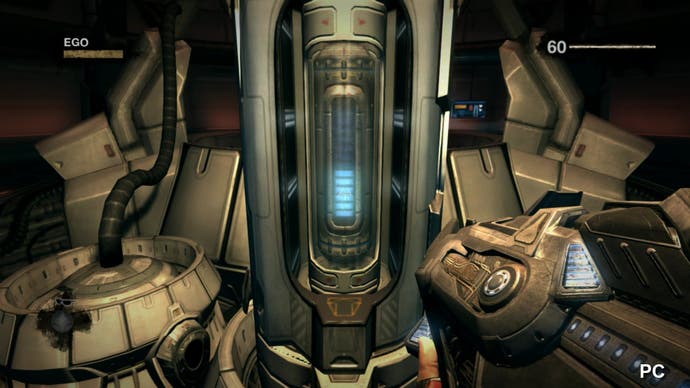Face-Off: Duke Nukem Forever
Sub atomic.
Quite why the Microsoft console has such a poor version of the game is something of a mystery. Duke Nukem Forever runs on what appears to be a very, very old Unreal Engine platform, and traditionally Epic's tech simply seems to play more nicely with the Xbox 360 architecture, designed from the ground up to be easy for PC developers to get to grips with. It may simply be the case that Piranha has better PlayStation 3 coders in-house, but regardless, the difference is substantial. On PS3, Duke Nukem Forever doesn't suddenly become a good game, but at least the game's positive elements are showcased in a somewhat better light.
Unsurprisingly, bearing in mind the original game concept and the muscle of Gearbox Software behind the final furlong of the monumental developmental effort, it's the PC version of the Duke Nukem Forever that offers up the best version of the game.
What you're seeing here is the 360 and PlayStation 3 SKUs up against the PC version maxed out on all settings, but still running at the same 720p output. The core art doesn't appear to be significantly improved, aside from the inclusion of higher-resolution normal maps, but it is running at native resolution (as you would expect for a PC title) and there are a number of additional effects such as depth of field and motion blur.
Some of these post-processing elements are appear to be rather heavy though, and the result is that some definition is lost: ramping up resolution helps here, but there's still the sense that the depth-of-field effect in particular is too pervasive.
We also feel that the game could do with a patch to improve performance. It's unclear what the issue is here, but a Core i7 920 at 2.66GHz working in combination with a GTX580 should be able to run this game at a sustained 720p60 with no issues whatsoever. However, we still encountered noticeable performance drops in certain areas and it didn't seem to matter that much what resolution we used, as 1080p did the same. Duke Nukem Forever just seemed to drop frames for unknown reasons.
Image quality is undoubtedly significantly improved over the console version though. There are two anti-aliasing modes in the PC version of the game - an important element in improving visual quality compared to the console versions. The traditional multi-sampling AA isn't present, but what we do see are FSAA and FXAA modes. While the former suggests a form of super-sampling - internally rendering at a higher resolution before downscaling to native resolution - in practice it looks more like a simple edge blur.


However, our shots and footage were taken using FXAA mode - a new post-process form of anti-aliasing designed by NVIDIA's Timothy Lottes that seeks to provide the edge-smoothing of MLAA but with reduced sub-pixel edge issues. PC and console iterations of the technology exist, where the strengths of the respective GPUs provide two settings: performance (console) and quality (PC). The smoothing effect on PC is perhaps not best suited to lower resolutions like 720p, though, and the FXAA seems to take away a little too much detail.
FXAA is an important technology for the future because the many game engines - like Unreal, plus a whole host of new deferred renderers - don't get along nicely with traditional multi-sampling AA. Duke Nukem Forever is interesting in that it is one of the first games where we've seen it implemented. Expect to see it being utilised on a great many console projects in the future, especially on Xbox 360 where GPU resources are typically more plentiful than they are on PlayStation 3. The console version of FXAA can process a 720p image in around 1ms, providing quite remarkable quality with only a very small performance hit.
Returning to the matter at hand, Duke Nukem Forever is a game that clearly suffers from mixed fortunes dependent on the platform you are playing it on, but is hardly an essential buy regardless of the gaming hardware you own. For Xbox 360 owners, voluntarily playing it is akin to video gaming masochism: dated visuals and gameplay made irredeemable by one of the most ugly, technically flawed applications of the older Unreal Engine we've ever seen. Even for those nostalgic about the character or genuinely curious about the game, the antique graphics and gameplay are let down badly by the terrible fluctuating performance of the engine and the near-constant screen-tear.
Things are significantly improved on the PlayStation 3. While the sub-HD resolution and the horrible aliasing are still very much in evidence, the frame-rate is pretty much a constant 30 frames per second and the vast majority of the tearing is gone. The player's handshake with the game is much improved and it's fair to say that the experience of playing it improves significantly: Duke Nukem Forever moves up a notch from a complete write-off to an interesting, occasionally enjoyable slice of retro gameplay.


The best way to play the game is on PC, the platform the game was originally designed to be played on. Visually the game is an improvement over the console versions, and there are some artwork boosts too - but the overall quality still varies dramatically throughout the game. In addition to this, PC owners can shape and smooth away most of the truly objectionable elements from the console versions, run the game at 60FPS (mostly) and thus enjoy Duke Nukem Forever in the best possible circumstances. We'll stop short of saying that it's the way the game was meant to be played because you can't help but feel that if 3D Realms hadn't run out of money, they would still be redefining and reinventing the game today.
As it is, the final product comes across as a bizarre amalgam of development work that spans several gaming generations and is in no way competitive with the modern first-person shooter by any criteria you care to mention. The X factor of the Duke Nukem character doesn't really add that much either when he has been handled in such a cack-handed way: the sub-adolescent humour and one-liners nicked from eighties action movies are more embarrassing than they are funny. If Gearbox harbours any ambitions for this character, the least it can do is put a decent writer behind the script for the next game.
Sifting through the detritus of the final release, you can't help but feel that Duke Nukem Forever would have worked better as a keenly priced retro release - perhaps in concert with a remastered Duke Nukem 3D. It would have seen the focus of the game shifted away from its many shortcomings and more towards the nostalgic elements. Presented as a museum piece of sorts, Duke Nukem Forever may have found more mercy at the hands of the rightly critical press.








